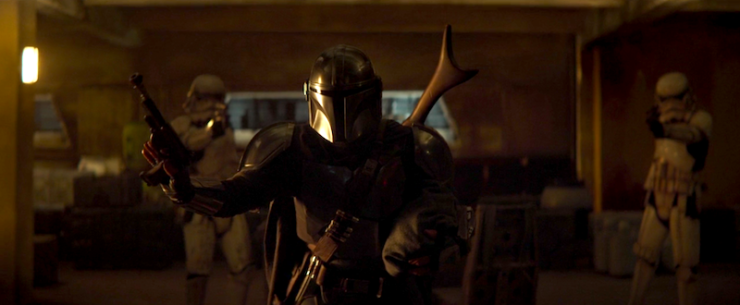The Mandalorian didn’t come here to make friends. Or, well, maybe he did. But it wasn’t intentional! We’re back in the thick of it in Chapter 3, “The Sin”.
Summary
The Mandalorian turns the Baby Yoda over to the Client, but he doesn’t feel great about it. He brings the beskar payment back to the secret Mando camp, delivering it up to his people. Another Mando tries to pick a fight, displeased that one of their own would work with Imperials after what they did to Mandalore, but Armorer reminds the group of their code and they quit squabbling. The Armorer makes the Mandalorian a matching pauldron and cuirass (that’s a breastplate and a backplate) from the beskar, as well as weapons called “whistling birds”—some are reserved for the foundlings. The Mandalorian goes to the cantina to meet up with Greef Karga for another bounty job, and finds out that every hunter in the Guild had a tracker for the kid. He asks what will happen to it, but Karga advises him to forget about it, since it’s against Guild policy to ask questions about bounties. The Mandalorian returns to his ship and is prepared to leave on the next bounty, but he’s reminded of the child, and changes his plans.
He breaks into the Client’s compound, retrieves the baby from Dr. Pershing (Omid Abtahi), and neutralizes the stormtroopers. All of the trackers on the kid are activated again, and the entire bounty hunting population of the town is set against him, Karga included. The Mandalorian continues fighting, but is vastly outnumbered. Just as it looks like he’s about to lose, fellow Mandalorians show up to defend him, as is their code; they will now have to relocate. The Mandalorian escapes with the Baby Yoda on his ship, only briefly deterred by Karga, whom he shoots in the chest. Karga is saved by the bounty’s share of beskar he had tucked into his clothes.
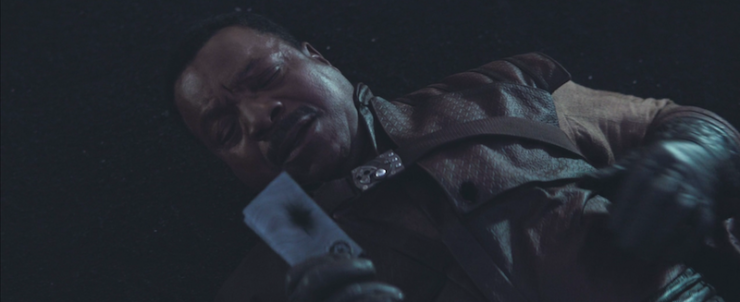
Commentary
The Client makes a point of saying that it’s now easier to find beskar metal than it is to find Mandalorian armor or the people who normally live inside it. Then the heavy infantry guy our Mando swaps blows with back at the compound makes it abundantly clear: Mandalore and its people were all but wiped about by the Empire. They are survivors of genocide, working to slowly rebuild their culture in the shadow of Imperial desolation.
So… that’s about as bad as I expected. But I’m still completely gutted over it.
So now, everything that the Mandalorian does will be weighed against that cost. If something happens to him or any of his people, that brings them closer to extinction. Taking up a cause instead of simply working to get by in the universe is a very dangerous game now. Which means that I feel like a bad person, but I’m glad our guy delivered on the bounty to get the beskar, and then came back for the baby. If only because retrieving that metal is essential, and it would have been extremely disappointing if he hadn’t brought home that prize. More importantly, he needs all the help he can get, so working toward completing that armor really is a priority.
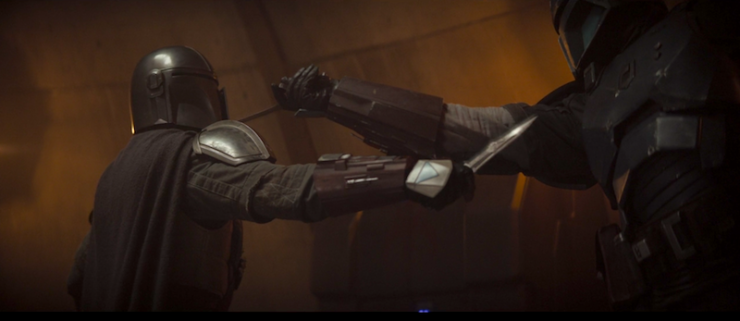
We’re seeing a significant amount of myth-building here with the Mandalorians, but we don’t know where it comes from in terms of timeline, i.e. if these are new rules and traditions that sprung up after the Purge, or they are rules that have always existed. Despite the fact that much of the rhetoric being introduced here is new, I’m inclined to think the latter; Mandalore as we’ve seen on screen thus far (as in the recent Star Wars animated series) has always been in a state of upheaval. Noting that, the Armorers insistence on keeping violence to a minimum within their compound isn’t a surprise—before and during the Empire, Mandalore went through many civil wars of their own, leaving their planet largely uninhabitable, and forcing their residents to live inside domed cities. Duchess Satine’s pacifist regime in the Clone War era was a direct response to those wars, though many Mando warriors refused to cooperate and were exiled to Mandalore’s moon, Concordia. The fight that we see break out between our guy and the infantry dude is common to Mandalorian culture, but they understandably cannot afford to get carried away anymore.
In addition, we’re seeing the importance of weapons to the culture, but explicitly the fact that no one is capable of making what they make in regard to weaponry. This is what made Mandalore a target of the Empire, and we can see it whenever they pull out some deadly tool that shocks everyone—Karga has seen our guy toting his Amban sniper rifle, and still didn’t know it could be used to disintegrate people. The Mandalorians are very careful about how and when and who they employ their weapons against because surprise is still their greatest asset. This also plays into the refusal to remove their helmets, a point that the Armorer brings up as a sort of mantra. Plenty of Mandalorian do not live inside their armor, but for those who are devoted, they rarely remove their helmet outside of groups they would term friends and family.
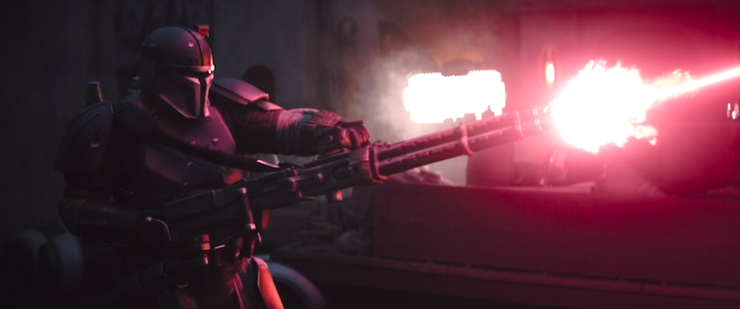
There are still plenty of questions to answer. The Armorer notes that creating the Mandalorian’s cuirass “would be in order for your station”, which probably has something to do with his clan? Either that, or he’s pretty high up on the food chain just by virtue of his deeds within this camp of Mandos. It’s possible that he’s in the process of creating his own clan, which could also explain his search for an appropriate signet. (His flashbacks are still too spare to give us much info, though that will obviously change.) But while we can see the unrest in these people, the key takeaway from this episode is that the Mandalorians stand with their own kind. They refused to leave our guy on his own, even knowing that showing their faces would mean relocation for their protection.
It’s still unclear what Baby Yoda is being used for, though plenty of theories have cropped up. The Client wasn’t interested in keeping it alive, so they clearly weren’t planning to raise a Force baby or anything like that. The question about it being a clone of Yoda still stands, along with other questions about Kamino’s involvement with the kid, whether they created it in their clone vats or something more sinister. Not that it matters much because watching the Mandalorian tote that little package in the crook of his arm and pretend he doesn’t love the kid is the emotional crux this show rides on, and dammit if it doesn’t work. He loves it. Enough to give it a piece of his ship that is probably a choking hazard and definitely not great for small stomachs.
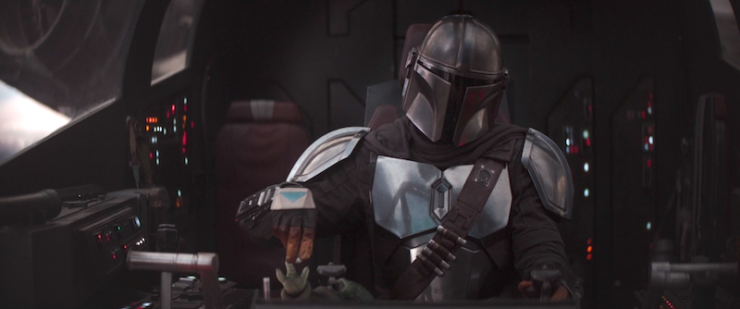
A very small but important clarification: After sidestepping its meaning in Solo, Karga has a line that makes it perfectly clear that “spice” is a drug in the Star Wars universe. The fact that Solo played coy about that and then tried to make it seem like Han only ever delivered fuel as a smuggler was goofy as all get out. Spice makes you “forget,” according to Karga. It’s a drug. The spice mines of Kessel are for drugs. Hopefully that won’t get glossed over again in the future.
There’s a little pet peeve I’d like to see resolved in regard to the armor. The show has those dulled, earthen tones that Star Wars loves to trot out among the good guy wardrobes and the wilds of their galaxy. But Sabine Wren (of Star Wars: Rebels) made a point of painting and repainting her armor in a bright rainbow array of colors. In doing do, she not only expressed herself, but she brought Mandalore’s artistic heritage to the fore. I’m not saying that every single one of these people needs brightly colored armor (they’re trying to keep themselves hidden and safe), but if this show saw the resurgence of the Mandalorian people, and if that could come with a little more artistic license with the armor, I’d be incredibly pleased.
Also, I really love that shoutout to the jetpack at the end of the episode. Such a perfect melding of actual desire with an aspect that all kids always loved about Fett’s armor when they were little. #GiveHimAJetpack
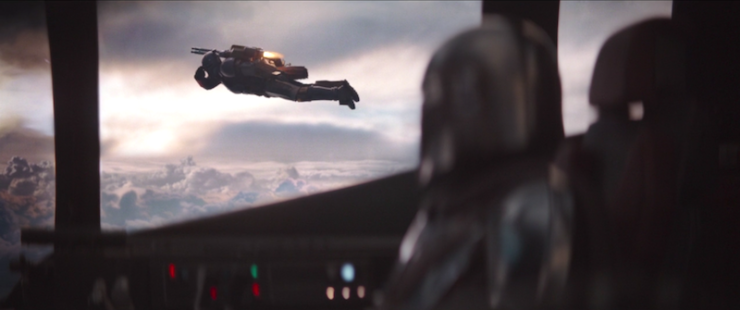
Things and asides:
- If you hadn’t already heard, the stormtroopers you see in this series are not actors in costumes provided by Lucasfilm—they are the 501st Legion, the largest and best known Star Wars cosplay group worldwide, founded in 1997. Members typically make their own armor from scratch, and nearby members were invited to participate in filming The Mandalorian (a smart way to both save on the production of stormtrooper armor and give some fans the chance of a lifetime). The filmmaking group were reportedly awed by the armor brought in by their extras, as no details are spared when the 501st is involved. The more I see them on-screen, the more tickled I get.
- We can see plenty of familiar bounty hunters in that firefight to get off-world, including a figure who looks an awful lot like Boushh (the bounty hunter Leia emulates in Return of the Jedi), and a droid that appears to be the same model as 4-LOM (who is also on Vader’s ship in Empire Strikes Back along with the rest of the bounty hunters).
- I’m gonna make a wild guess here, because the voice of that heavy infantry Mandalorian who fought with our guy was super familiar. The actor in the armor is Tait Fletcher, but the voice sounded an awful lot like Jon Favreau. If true, that would be a twofold cameo; not only is he the creator/writer/producer and so on of the show, Favreau actually voiced a Mandalorian in Star Wars: The Clone Wars, a fella named Pre Vizsla, who headed up the Mandalorian Death Watch and hated Duchess Satine’s new pacifist regime. Vizsla was eventually executed by Darth Maul when the former Sith apprentice took over the system, but this new Mando with a very similar voice could easily be another member of the former Clan Vizsla.
- Really curious as to how the “whistling birds” weapon works. I would assume it targets something like all the heat or carbon dioxide signatures outside of the user who fired it, but then how does Baby Yoda make it? Too small? It probably doesn’t work that way at all, ignore me.
- The container for the beskar is referred to as a “camtono”, the same carrier that Carga suggested for spice, making it an all purpose piece of equipment. This is mostly funny because “camtono” probably came from a viral video where a little girl tries to say “ice cream” and it comes out as “camtono” instead. It’s very on par with the myriad of weird ways Star Wars comes up with names.
Emmet Asher-Perrin forgot to mention that when they were an infant, their oarents used to call them Yoda. So in effect, they were the original baby Yoda? You can bug him on Twitter, and read more of her work here and elsewhere.










